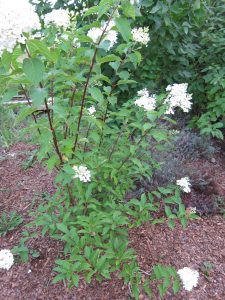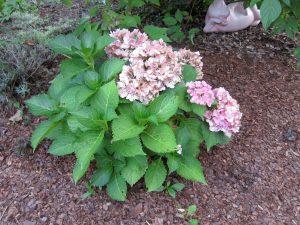
Leggy Hydrangea
Photos submitted by S.P., Noble County
Q. I’ve attached photos of my hydrangeas. While they both produce blooms, both seem to have problems. The paniculata Vanilla Strawberry, as you can see, is kind of sparse, not full like others I’ve seen. I believe the other is an arborescens Annabelle. This one never grows more than about 18 inches high and gets very droopy, requiring a lot of water. Both get morning sun and more later in the day. Annabelle is shaded by a red twig dogwood. Do you have any suggestions for me? – S.P., Noble County
A. The plant in your first photo looks like it might just be too shady, the stems look rather stretched with long internodes. Hydrangea paniculata tends to need more sun than some of the other species. If you can’t provide more sun in its current location, you might consider transplanting to different spot.

Compact Hydrangea
The plant in your second photo does not appear to be Annabelle, which is a rather tall, white-flowering H. arborescens. Yours looks more like one of the H. macrophyllacultivars – there are some compact selections that stay short and dense like that in your photo. In fact, your plant looks pretty healthy! If this plant is frequently wilting while other plants in the same plot are not, it could be that it needs a bit more afternoon shade. Maybe the two specimens should switch places!
You’ll find further information on hydrangeas athttp://www.hort.purdue.edu/ext/season_news/july2014.html
Q. I have problems keeping my cucumbers alive after they start producing. They were looking bad a few weeks ago, so I increased the watering, and they looked a little better. I then mulched with grass clippings to retain some of the water, but I am not sure they will make it long. Do you have any suggestions? – J.G.
A. One of the most common problems in cucumbers is bacterial wilt that is transmitted to the plants by either striped or spotted cucumber beetles. Typically you’ll first notice some wilted leaves about the same time as fruits begin to set. Soon after, the entire plant will collapse as the bacteria rapidly multiply and clog the vessels that transport water in the plant. There is no cure for this bacterial disease, so your only hope is to prevent beetles from feeding on the plants.
Young plants appear to be the most susceptible, so early-season control of the cucumber beetle may be enough to get the plants through. Floating row covers can provide good early protection but will need to be lifted to allow bees to pollinate as plants begin flowering. Yellow sticky traps can reduce beetle feeding, if placed around the borders or within the row about every 20 feet. Replace as needed when they are no longer sticky.
There are a few insecticides labeled for this pest, but be sure to read and carefully follow the label directions. Using the wrong product or applying at the wrong time could kill the pollinator bees. Additional information on bacterial wilt and controlling cucumber beetles is available at
http://www.ppdl.purdue.edu/PPDL/weeklypics/4-4-11.html and
http://extension.entm.purdue.edu/publications/E-21.pdf
Q. My husband and I have always had a garden with tomatoes. This year our bountiful crop looks ripe but are hard and tasteless. Can you tell me why they are like that, or what we have done wrong when planting or raising them? We have beautiful, tall plants with a lot of tomatoes on them. We have had plenty of rain and sunshine. – E.L., Clay County
A. You were in good company this year as many gardeners noted their tomatoes were quite slow to ripen. Even if fruits appeared ripe, the development of carbohydrates and softening enzymes within the fruit might have needed a bit more time to catch up.
I suspect this summer’s relatively cool temperatures to be the primary culprit for slow ripening. According to the Indiana State Climate Office, July was unseasonably cool, in fact the second coolest July on record. And because we experienced a late spring as well, many gardeners planted a bit later than usual.
Tomato fruits typically need about 40-50 days from fruit set to mature green. Once the tomatoes have reached the mature green stage, they need about 10-14 more days to ripen at optimal temperature, 68–77 degrees F. Maturation and ripening will be considerably delayed when temperatures are less than optimum. As warmer temperatures prevailed in August, tomato ripening should have improved.